Airbus: Corporate Governance, Leadership, and Business Analysis Report
VerifiedAdded on 2020/04/15
|11
|3280
|48
Report
AI Summary
This report provides a comprehensive analysis of Airbus, a leading European multinational company in the aeronautical industry. It explores the company's leadership strategies, emphasizing their role in managing business operations and adapting to market challenges. The report delves into Airbus's organizational structure and culture, highlighting the significance of teamwork, diversity, and a positive working environment. Furthermore, it examines the company's commitment to business sustainability, including its eco-efficiency system and efforts to reduce environmental impact. The report also discusses corporate governance practices within Airbus, focusing on the roles of the board of directors and stakeholders in maintaining ethical standards and ensuring the company's long-term success. Overall, the report provides valuable insights into how Airbus has become a global leader through effective leadership, a strong organizational culture, and a commitment to sustainability and corporate governance.
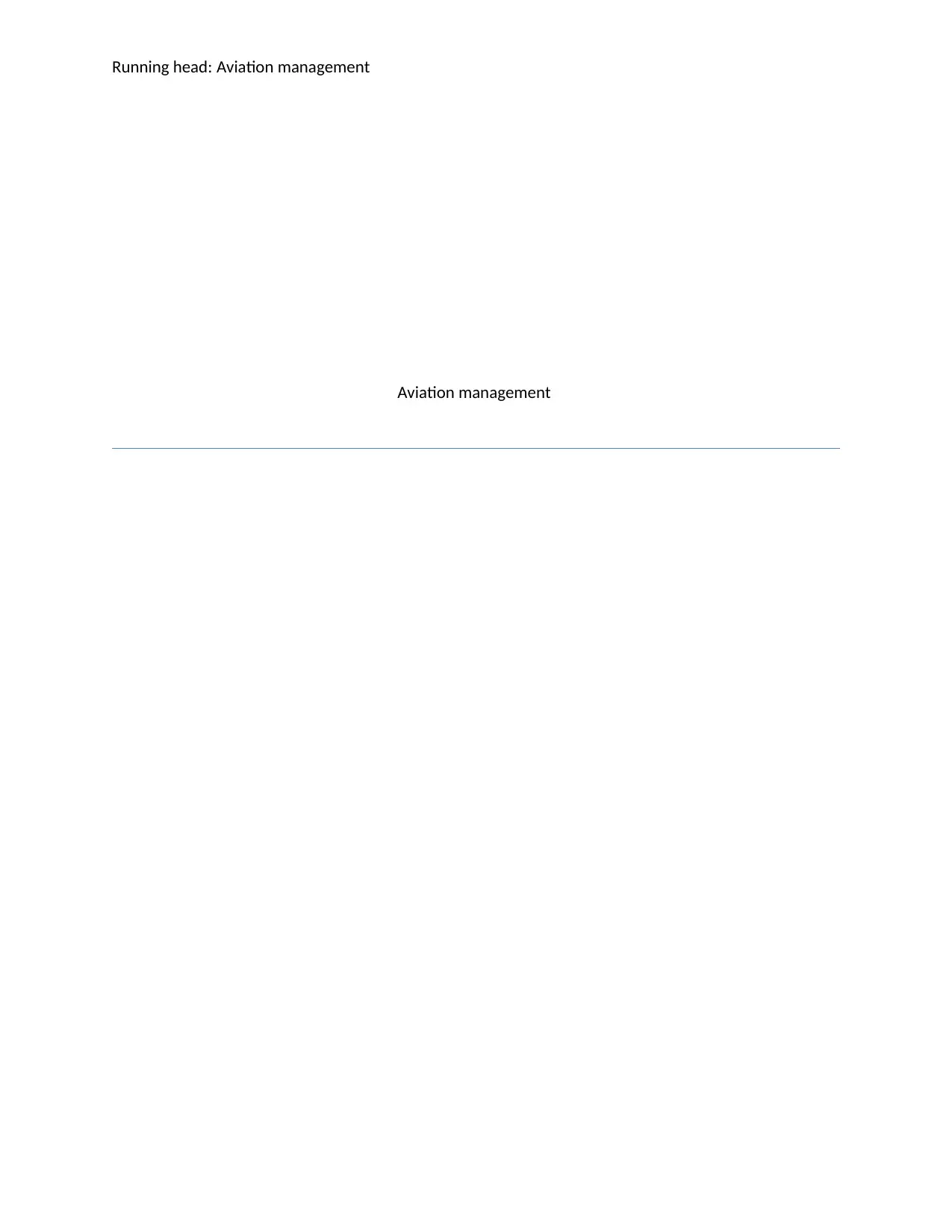
Running head: Aviation management
Aviation management
Aviation management
Paraphrase This Document
Need a fresh take? Get an instant paraphrase of this document with our AI Paraphraser
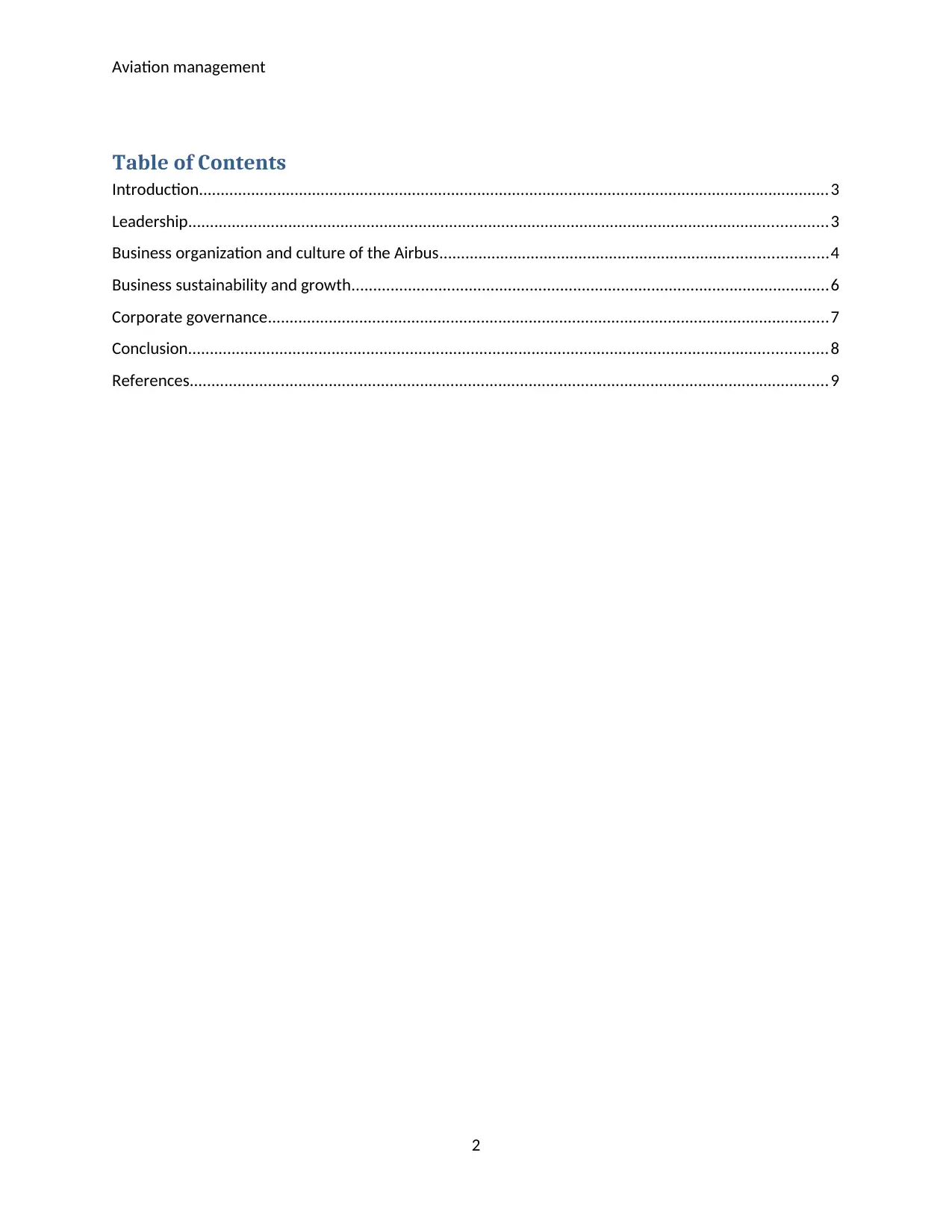
Aviation management
Table of Contents
Introduction.................................................................................................................................................3
Leadership...................................................................................................................................................3
Business organization and culture of the Airbus.........................................................................................4
Business sustainability and growth..............................................................................................................6
Corporate governance.................................................................................................................................7
Conclusion...................................................................................................................................................8
References...................................................................................................................................................9
2
Table of Contents
Introduction.................................................................................................................................................3
Leadership...................................................................................................................................................3
Business organization and culture of the Airbus.........................................................................................4
Business sustainability and growth..............................................................................................................6
Corporate governance.................................................................................................................................7
Conclusion...................................................................................................................................................8
References...................................................................................................................................................9
2
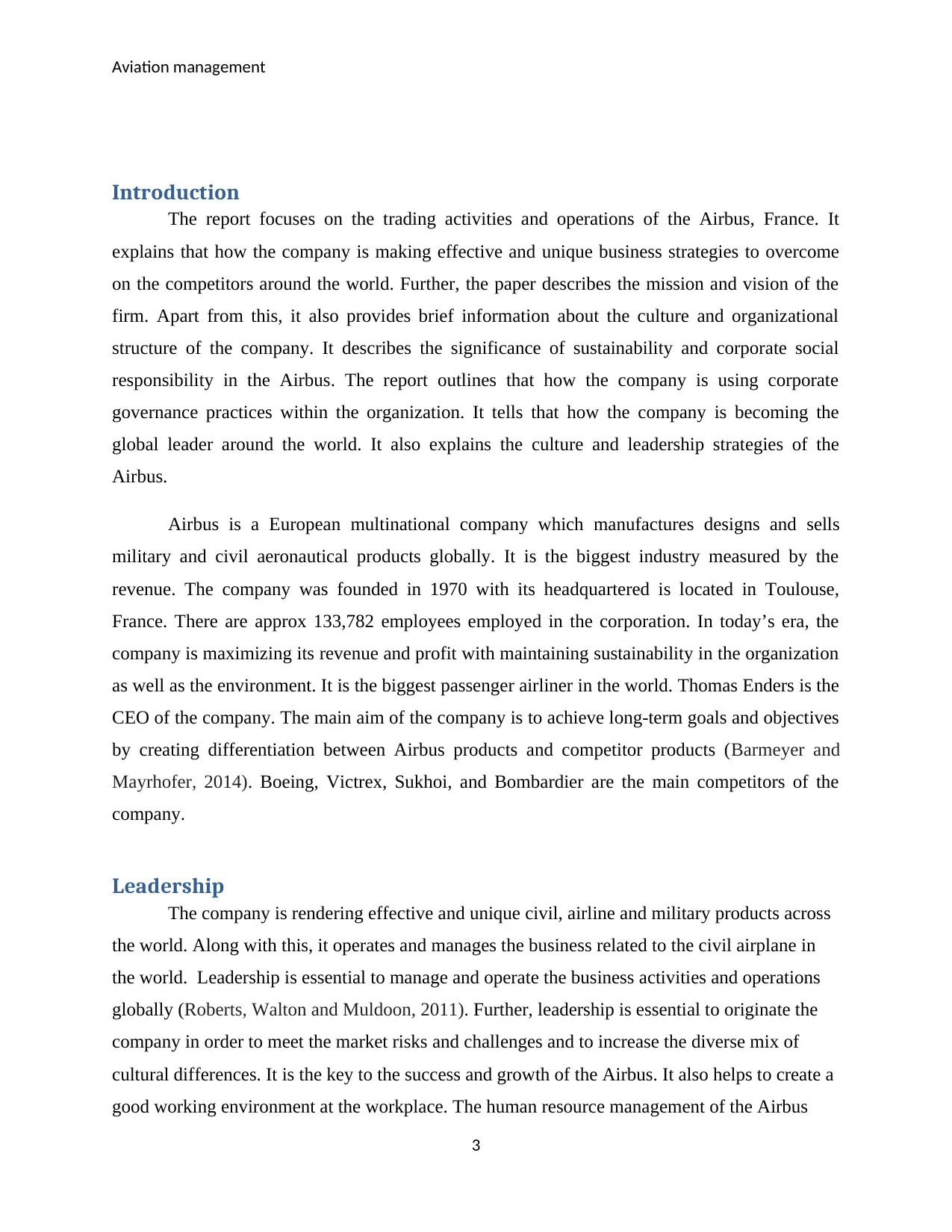
Aviation management
Introduction
The report focuses on the trading activities and operations of the Airbus, France. It
explains that how the company is making effective and unique business strategies to overcome
on the competitors around the world. Further, the paper describes the mission and vision of the
firm. Apart from this, it also provides brief information about the culture and organizational
structure of the company. It describes the significance of sustainability and corporate social
responsibility in the Airbus. The report outlines that how the company is using corporate
governance practices within the organization. It tells that how the company is becoming the
global leader around the world. It also explains the culture and leadership strategies of the
Airbus.
Airbus is a European multinational company which manufactures designs and sells
military and civil aeronautical products globally. It is the biggest industry measured by the
revenue. The company was founded in 1970 with its headquartered is located in Toulouse,
France. There are approx 133,782 employees employed in the corporation. In today’s era, the
company is maximizing its revenue and profit with maintaining sustainability in the organization
as well as the environment. It is the biggest passenger airliner in the world. Thomas Enders is the
CEO of the company. The main aim of the company is to achieve long-term goals and objectives
by creating differentiation between Airbus products and competitor products (Barmeyer and
Mayrhofer, 2014). Boeing, Victrex, Sukhoi, and Bombardier are the main competitors of the
company.
Leadership
The company is rendering effective and unique civil, airline and military products across
the world. Along with this, it operates and manages the business related to the civil airplane in
the world. Leadership is essential to manage and operate the business activities and operations
globally (Roberts, Walton and Muldoon, 2011). Further, leadership is essential to originate the
company in order to meet the market risks and challenges and to increase the diverse mix of
cultural differences. It is the key to the success and growth of the Airbus. It also helps to create a
good working environment at the workplace. The human resource management of the Airbus
3
Introduction
The report focuses on the trading activities and operations of the Airbus, France. It
explains that how the company is making effective and unique business strategies to overcome
on the competitors around the world. Further, the paper describes the mission and vision of the
firm. Apart from this, it also provides brief information about the culture and organizational
structure of the company. It describes the significance of sustainability and corporate social
responsibility in the Airbus. The report outlines that how the company is using corporate
governance practices within the organization. It tells that how the company is becoming the
global leader around the world. It also explains the culture and leadership strategies of the
Airbus.
Airbus is a European multinational company which manufactures designs and sells
military and civil aeronautical products globally. It is the biggest industry measured by the
revenue. The company was founded in 1970 with its headquartered is located in Toulouse,
France. There are approx 133,782 employees employed in the corporation. In today’s era, the
company is maximizing its revenue and profit with maintaining sustainability in the organization
as well as the environment. It is the biggest passenger airliner in the world. Thomas Enders is the
CEO of the company. The main aim of the company is to achieve long-term goals and objectives
by creating differentiation between Airbus products and competitor products (Barmeyer and
Mayrhofer, 2014). Boeing, Victrex, Sukhoi, and Bombardier are the main competitors of the
company.
Leadership
The company is rendering effective and unique civil, airline and military products across
the world. Along with this, it operates and manages the business related to the civil airplane in
the world. Leadership is essential to manage and operate the business activities and operations
globally (Roberts, Walton and Muldoon, 2011). Further, leadership is essential to originate the
company in order to meet the market risks and challenges and to increase the diverse mix of
cultural differences. It is the key to the success and growth of the Airbus. It also helps to create a
good working environment at the workplace. The human resource management of the Airbus
3
⊘ This is a preview!⊘
Do you want full access?
Subscribe today to unlock all pages.

Trusted by 1+ million students worldwide
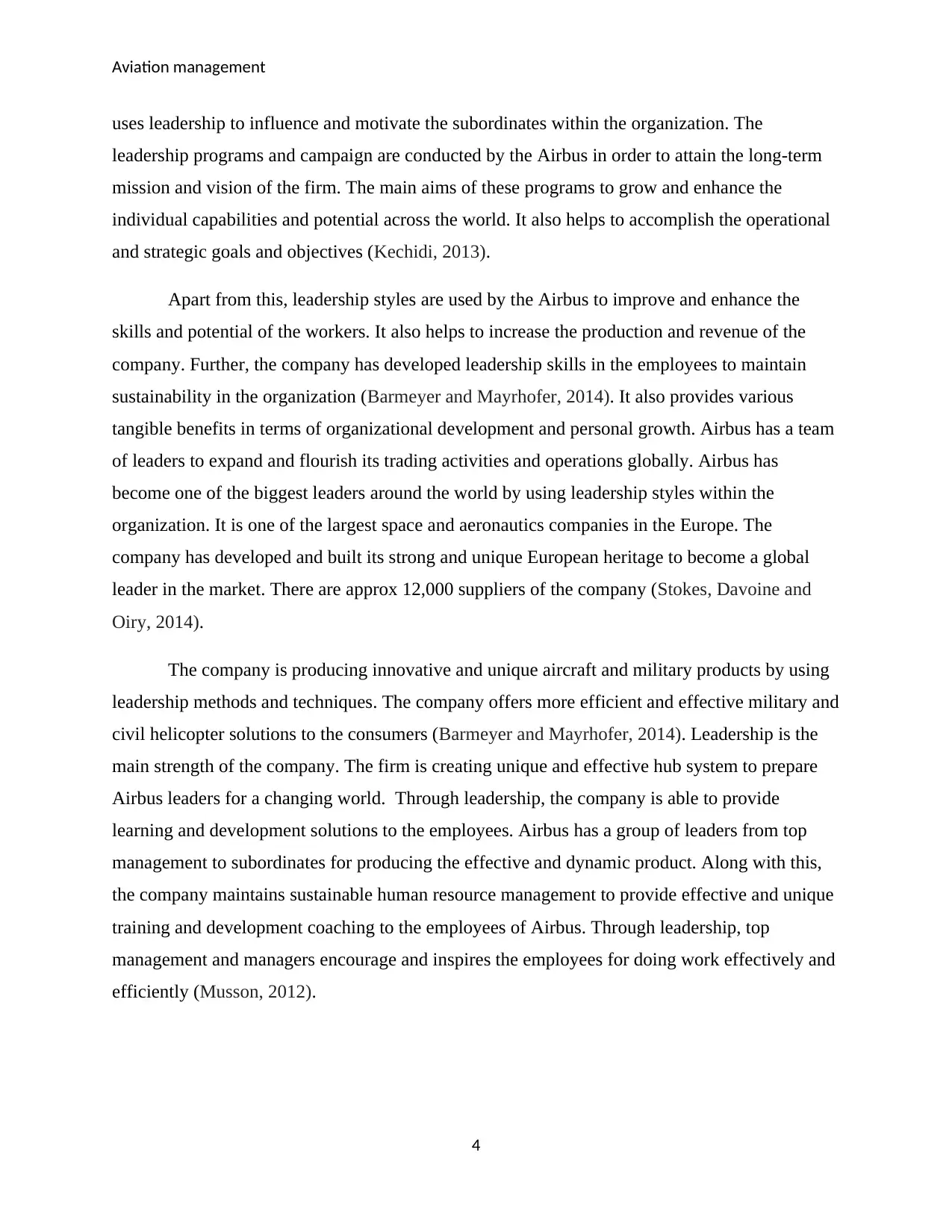
Aviation management
uses leadership to influence and motivate the subordinates within the organization. The
leadership programs and campaign are conducted by the Airbus in order to attain the long-term
mission and vision of the firm. The main aims of these programs to grow and enhance the
individual capabilities and potential across the world. It also helps to accomplish the operational
and strategic goals and objectives (Kechidi, 2013).
Apart from this, leadership styles are used by the Airbus to improve and enhance the
skills and potential of the workers. It also helps to increase the production and revenue of the
company. Further, the company has developed leadership skills in the employees to maintain
sustainability in the organization (Barmeyer and Mayrhofer, 2014). It also provides various
tangible benefits in terms of organizational development and personal growth. Airbus has a team
of leaders to expand and flourish its trading activities and operations globally. Airbus has
become one of the biggest leaders around the world by using leadership styles within the
organization. It is one of the largest space and aeronautics companies in the Europe. The
company has developed and built its strong and unique European heritage to become a global
leader in the market. There are approx 12,000 suppliers of the company (Stokes, Davoine and
Oiry, 2014).
The company is producing innovative and unique aircraft and military products by using
leadership methods and techniques. The company offers more efficient and effective military and
civil helicopter solutions to the consumers (Barmeyer and Mayrhofer, 2014). Leadership is the
main strength of the company. The firm is creating unique and effective hub system to prepare
Airbus leaders for a changing world. Through leadership, the company is able to provide
learning and development solutions to the employees. Airbus has a group of leaders from top
management to subordinates for producing the effective and dynamic product. Along with this,
the company maintains sustainable human resource management to provide effective and unique
training and development coaching to the employees of Airbus. Through leadership, top
management and managers encourage and inspires the employees for doing work effectively and
efficiently (Musson, 2012).
4
uses leadership to influence and motivate the subordinates within the organization. The
leadership programs and campaign are conducted by the Airbus in order to attain the long-term
mission and vision of the firm. The main aims of these programs to grow and enhance the
individual capabilities and potential across the world. It also helps to accomplish the operational
and strategic goals and objectives (Kechidi, 2013).
Apart from this, leadership styles are used by the Airbus to improve and enhance the
skills and potential of the workers. It also helps to increase the production and revenue of the
company. Further, the company has developed leadership skills in the employees to maintain
sustainability in the organization (Barmeyer and Mayrhofer, 2014). It also provides various
tangible benefits in terms of organizational development and personal growth. Airbus has a team
of leaders to expand and flourish its trading activities and operations globally. Airbus has
become one of the biggest leaders around the world by using leadership styles within the
organization. It is one of the largest space and aeronautics companies in the Europe. The
company has developed and built its strong and unique European heritage to become a global
leader in the market. There are approx 12,000 suppliers of the company (Stokes, Davoine and
Oiry, 2014).
The company is producing innovative and unique aircraft and military products by using
leadership methods and techniques. The company offers more efficient and effective military and
civil helicopter solutions to the consumers (Barmeyer and Mayrhofer, 2014). Leadership is the
main strength of the company. The firm is creating unique and effective hub system to prepare
Airbus leaders for a changing world. Through leadership, the company is able to provide
learning and development solutions to the employees. Airbus has a group of leaders from top
management to subordinates for producing the effective and dynamic product. Along with this,
the company maintains sustainable human resource management to provide effective and unique
training and development coaching to the employees of Airbus. Through leadership, top
management and managers encourage and inspires the employees for doing work effectively and
efficiently (Musson, 2012).
4
Paraphrase This Document
Need a fresh take? Get an instant paraphrase of this document with our AI Paraphraser
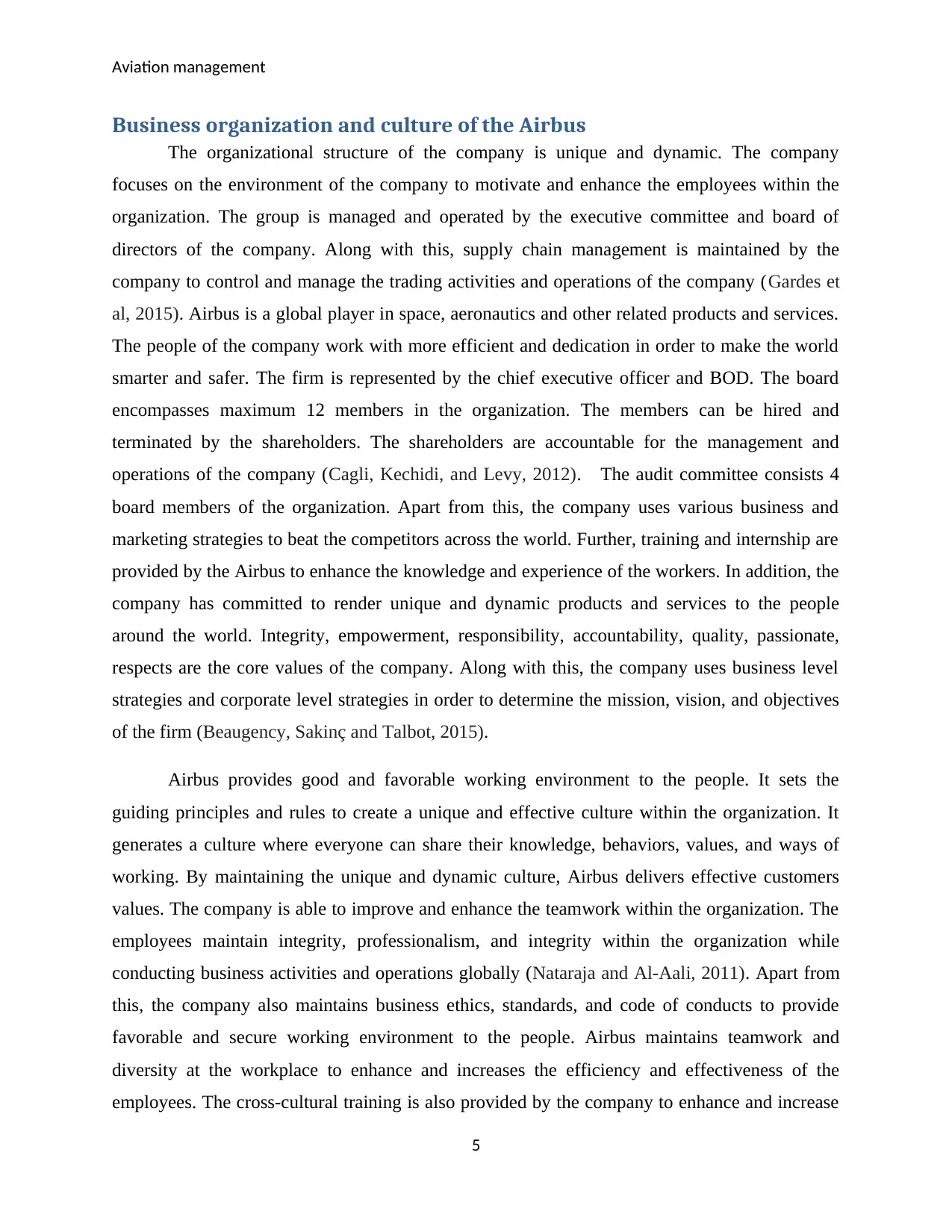
Aviation management
Business organization and culture of the Airbus
The organizational structure of the company is unique and dynamic. The company
focuses on the environment of the company to motivate and enhance the employees within the
organization. The group is managed and operated by the executive committee and board of
directors of the company. Along with this, supply chain management is maintained by the
company to control and manage the trading activities and operations of the company (Gardes et
al, 2015). Airbus is a global player in space, aeronautics and other related products and services.
The people of the company work with more efficient and dedication in order to make the world
smarter and safer. The firm is represented by the chief executive officer and BOD. The board
encompasses maximum 12 members in the organization. The members can be hired and
terminated by the shareholders. The shareholders are accountable for the management and
operations of the company (Cagli, Kechidi, and Levy, 2012). The audit committee consists 4
board members of the organization. Apart from this, the company uses various business and
marketing strategies to beat the competitors across the world. Further, training and internship are
provided by the Airbus to enhance the knowledge and experience of the workers. In addition, the
company has committed to render unique and dynamic products and services to the people
around the world. Integrity, empowerment, responsibility, accountability, quality, passionate,
respects are the core values of the company. Along with this, the company uses business level
strategies and corporate level strategies in order to determine the mission, vision, and objectives
of the firm (Beaugency, Sakinç and Talbot, 2015).
Airbus provides good and favorable working environment to the people. It sets the
guiding principles and rules to create a unique and effective culture within the organization. It
generates a culture where everyone can share their knowledge, behaviors, values, and ways of
working. By maintaining the unique and dynamic culture, Airbus delivers effective customers
values. The company is able to improve and enhance the teamwork within the organization. The
employees maintain integrity, professionalism, and integrity within the organization while
conducting business activities and operations globally (Nataraja and Al-Aali, 2011). Apart from
this, the company also maintains business ethics, standards, and code of conducts to provide
favorable and secure working environment to the people. Airbus maintains teamwork and
diversity at the workplace to enhance and increases the efficiency and effectiveness of the
employees. The cross-cultural training is also provided by the company to enhance and increase
5
Business organization and culture of the Airbus
The organizational structure of the company is unique and dynamic. The company
focuses on the environment of the company to motivate and enhance the employees within the
organization. The group is managed and operated by the executive committee and board of
directors of the company. Along with this, supply chain management is maintained by the
company to control and manage the trading activities and operations of the company (Gardes et
al, 2015). Airbus is a global player in space, aeronautics and other related products and services.
The people of the company work with more efficient and dedication in order to make the world
smarter and safer. The firm is represented by the chief executive officer and BOD. The board
encompasses maximum 12 members in the organization. The members can be hired and
terminated by the shareholders. The shareholders are accountable for the management and
operations of the company (Cagli, Kechidi, and Levy, 2012). The audit committee consists 4
board members of the organization. Apart from this, the company uses various business and
marketing strategies to beat the competitors across the world. Further, training and internship are
provided by the Airbus to enhance the knowledge and experience of the workers. In addition, the
company has committed to render unique and dynamic products and services to the people
around the world. Integrity, empowerment, responsibility, accountability, quality, passionate,
respects are the core values of the company. Along with this, the company uses business level
strategies and corporate level strategies in order to determine the mission, vision, and objectives
of the firm (Beaugency, Sakinç and Talbot, 2015).
Airbus provides good and favorable working environment to the people. It sets the
guiding principles and rules to create a unique and effective culture within the organization. It
generates a culture where everyone can share their knowledge, behaviors, values, and ways of
working. By maintaining the unique and dynamic culture, Airbus delivers effective customers
values. The company is able to improve and enhance the teamwork within the organization. The
employees maintain integrity, professionalism, and integrity within the organization while
conducting business activities and operations globally (Nataraja and Al-Aali, 2011). Apart from
this, the company also maintains business ethics, standards, and code of conducts to provide
favorable and secure working environment to the people. Airbus maintains teamwork and
diversity at the workplace to enhance and increases the efficiency and effectiveness of the
employees. The cross-cultural training is also provided by the company to enhance and increase
5
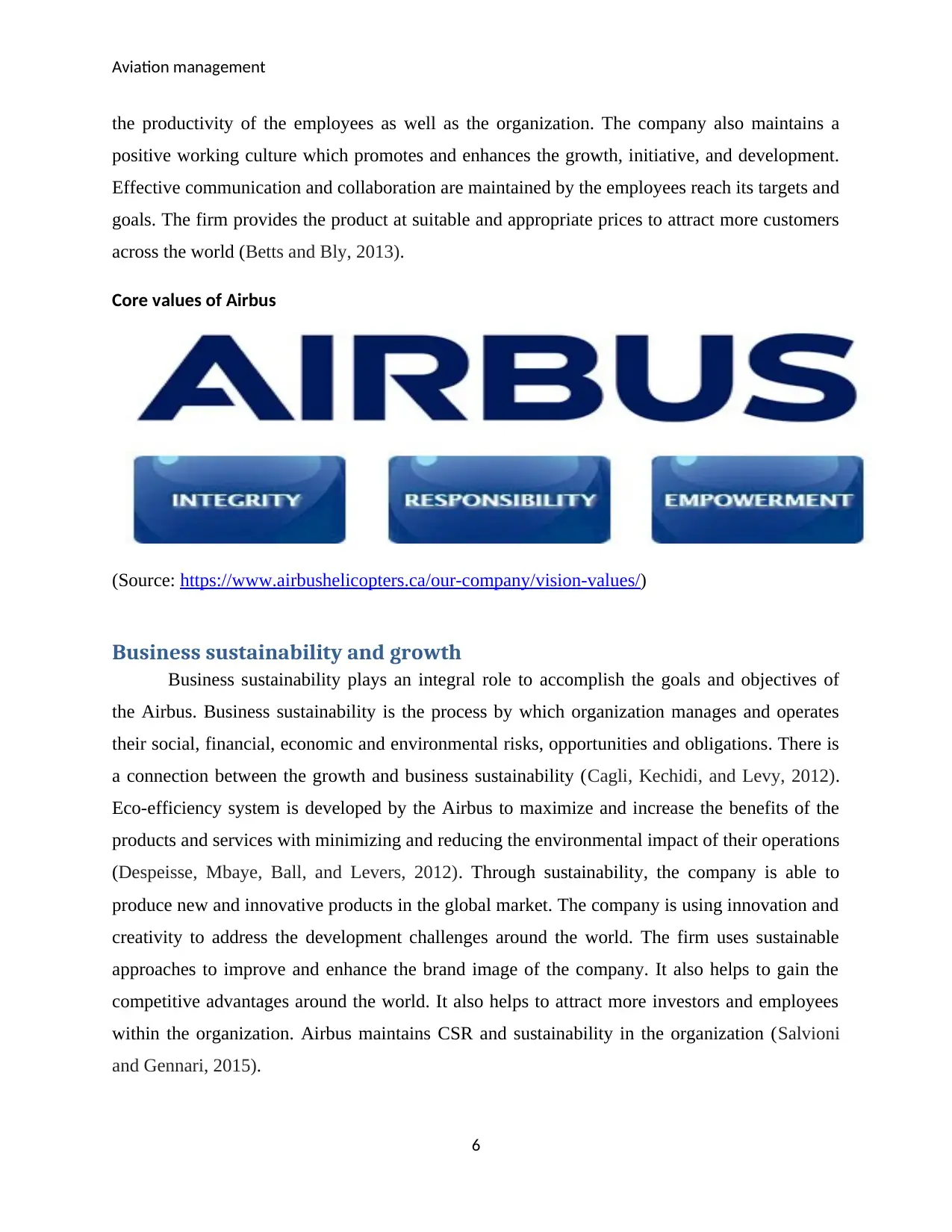
Aviation management
the productivity of the employees as well as the organization. The company also maintains a
positive working culture which promotes and enhances the growth, initiative, and development.
Effective communication and collaboration are maintained by the employees reach its targets and
goals. The firm provides the product at suitable and appropriate prices to attract more customers
across the world (Betts and Bly, 2013).
Core values of Airbus
(Source: https://www.airbushelicopters.ca/our-company/vision-values/)
Business sustainability and growth
Business sustainability plays an integral role to accomplish the goals and objectives of
the Airbus. Business sustainability is the process by which organization manages and operates
their social, financial, economic and environmental risks, opportunities and obligations. There is
a connection between the growth and business sustainability (Cagli, Kechidi, and Levy, 2012).
Eco-efficiency system is developed by the Airbus to maximize and increase the benefits of the
products and services with minimizing and reducing the environmental impact of their operations
(Despeisse, Mbaye, Ball, and Levers, 2012). Through sustainability, the company is able to
produce new and innovative products in the global market. The company is using innovation and
creativity to address the development challenges around the world. The firm uses sustainable
approaches to improve and enhance the brand image of the company. It also helps to gain the
competitive advantages around the world. It also helps to attract more investors and employees
within the organization. Airbus maintains CSR and sustainability in the organization (Salvioni
and Gennari, 2015).
6
the productivity of the employees as well as the organization. The company also maintains a
positive working culture which promotes and enhances the growth, initiative, and development.
Effective communication and collaboration are maintained by the employees reach its targets and
goals. The firm provides the product at suitable and appropriate prices to attract more customers
across the world (Betts and Bly, 2013).
Core values of Airbus
(Source: https://www.airbushelicopters.ca/our-company/vision-values/)
Business sustainability and growth
Business sustainability plays an integral role to accomplish the goals and objectives of
the Airbus. Business sustainability is the process by which organization manages and operates
their social, financial, economic and environmental risks, opportunities and obligations. There is
a connection between the growth and business sustainability (Cagli, Kechidi, and Levy, 2012).
Eco-efficiency system is developed by the Airbus to maximize and increase the benefits of the
products and services with minimizing and reducing the environmental impact of their operations
(Despeisse, Mbaye, Ball, and Levers, 2012). Through sustainability, the company is able to
produce new and innovative products in the global market. The company is using innovation and
creativity to address the development challenges around the world. The firm uses sustainable
approaches to improve and enhance the brand image of the company. It also helps to gain the
competitive advantages around the world. It also helps to attract more investors and employees
within the organization. Airbus maintains CSR and sustainability in the organization (Salvioni
and Gennari, 2015).
6
⊘ This is a preview!⊘
Do you want full access?
Subscribe today to unlock all pages.

Trusted by 1+ million students worldwide
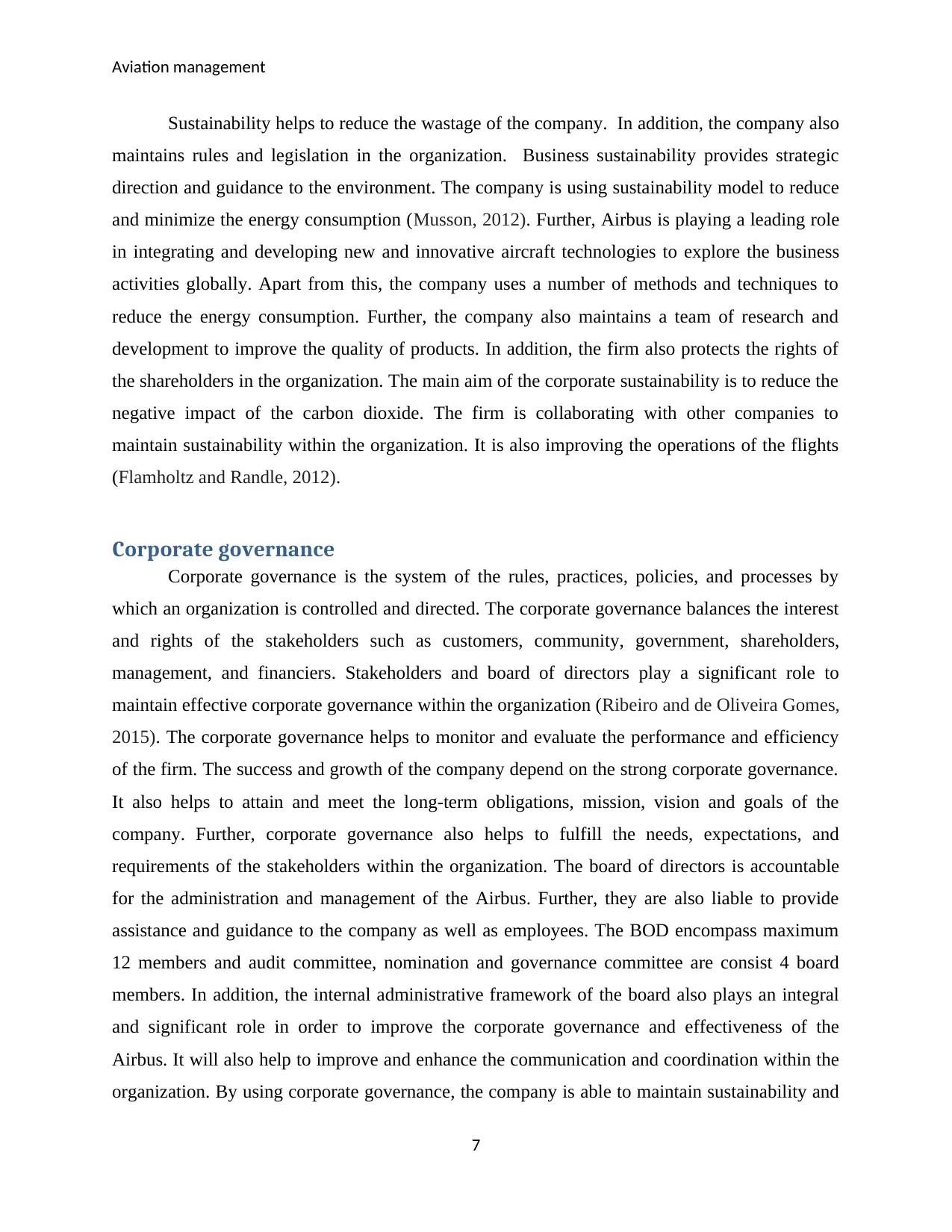
Aviation management
Sustainability helps to reduce the wastage of the company. In addition, the company also
maintains rules and legislation in the organization. Business sustainability provides strategic
direction and guidance to the environment. The company is using sustainability model to reduce
and minimize the energy consumption (Musson, 2012). Further, Airbus is playing a leading role
in integrating and developing new and innovative aircraft technologies to explore the business
activities globally. Apart from this, the company uses a number of methods and techniques to
reduce the energy consumption. Further, the company also maintains a team of research and
development to improve the quality of products. In addition, the firm also protects the rights of
the shareholders in the organization. The main aim of the corporate sustainability is to reduce the
negative impact of the carbon dioxide. The firm is collaborating with other companies to
maintain sustainability within the organization. It is also improving the operations of the flights
(Flamholtz and Randle, 2012).
Corporate governance
Corporate governance is the system of the rules, practices, policies, and processes by
which an organization is controlled and directed. The corporate governance balances the interest
and rights of the stakeholders such as customers, community, government, shareholders,
management, and financiers. Stakeholders and board of directors play a significant role to
maintain effective corporate governance within the organization (Ribeiro and de Oliveira Gomes,
2015). The corporate governance helps to monitor and evaluate the performance and efficiency
of the firm. The success and growth of the company depend on the strong corporate governance.
It also helps to attain and meet the long-term obligations, mission, vision and goals of the
company. Further, corporate governance also helps to fulfill the needs, expectations, and
requirements of the stakeholders within the organization. The board of directors is accountable
for the administration and management of the Airbus. Further, they are also liable to provide
assistance and guidance to the company as well as employees. The BOD encompass maximum
12 members and audit committee, nomination and governance committee are consist 4 board
members. In addition, the internal administrative framework of the board also plays an integral
and significant role in order to improve the corporate governance and effectiveness of the
Airbus. It will also help to improve and enhance the communication and coordination within the
organization. By using corporate governance, the company is able to maintain sustainability and
7
Sustainability helps to reduce the wastage of the company. In addition, the company also
maintains rules and legislation in the organization. Business sustainability provides strategic
direction and guidance to the environment. The company is using sustainability model to reduce
and minimize the energy consumption (Musson, 2012). Further, Airbus is playing a leading role
in integrating and developing new and innovative aircraft technologies to explore the business
activities globally. Apart from this, the company uses a number of methods and techniques to
reduce the energy consumption. Further, the company also maintains a team of research and
development to improve the quality of products. In addition, the firm also protects the rights of
the shareholders in the organization. The main aim of the corporate sustainability is to reduce the
negative impact of the carbon dioxide. The firm is collaborating with other companies to
maintain sustainability within the organization. It is also improving the operations of the flights
(Flamholtz and Randle, 2012).
Corporate governance
Corporate governance is the system of the rules, practices, policies, and processes by
which an organization is controlled and directed. The corporate governance balances the interest
and rights of the stakeholders such as customers, community, government, shareholders,
management, and financiers. Stakeholders and board of directors play a significant role to
maintain effective corporate governance within the organization (Ribeiro and de Oliveira Gomes,
2015). The corporate governance helps to monitor and evaluate the performance and efficiency
of the firm. The success and growth of the company depend on the strong corporate governance.
It also helps to attain and meet the long-term obligations, mission, vision and goals of the
company. Further, corporate governance also helps to fulfill the needs, expectations, and
requirements of the stakeholders within the organization. The board of directors is accountable
for the administration and management of the Airbus. Further, they are also liable to provide
assistance and guidance to the company as well as employees. The BOD encompass maximum
12 members and audit committee, nomination and governance committee are consist 4 board
members. In addition, the internal administrative framework of the board also plays an integral
and significant role in order to improve the corporate governance and effectiveness of the
Airbus. It will also help to improve and enhance the communication and coordination within the
organization. By using corporate governance, the company is able to maintain sustainability and
7
Paraphrase This Document
Need a fresh take? Get an instant paraphrase of this document with our AI Paraphraser
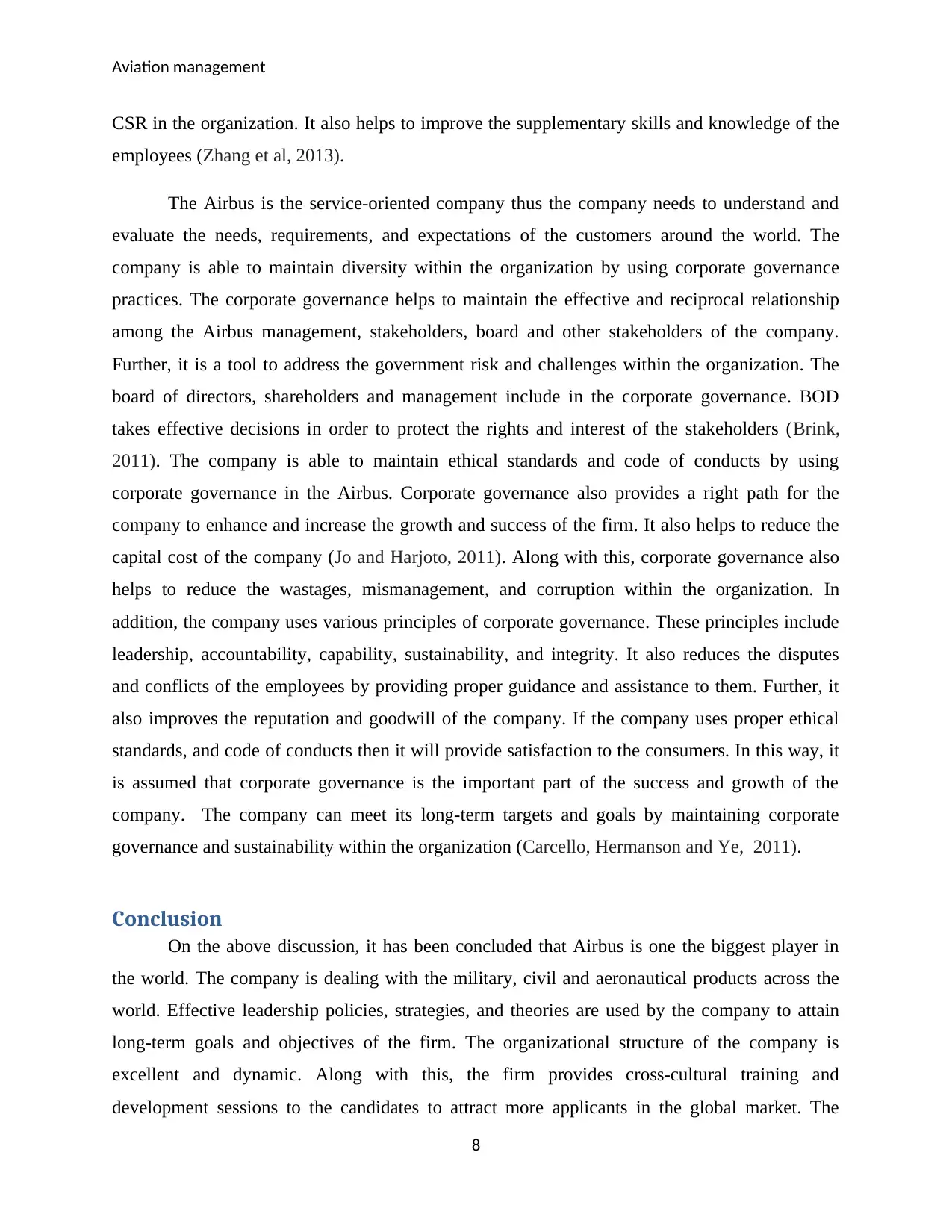
Aviation management
CSR in the organization. It also helps to improve the supplementary skills and knowledge of the
employees (Zhang et al, 2013).
The Airbus is the service-oriented company thus the company needs to understand and
evaluate the needs, requirements, and expectations of the customers around the world. The
company is able to maintain diversity within the organization by using corporate governance
practices. The corporate governance helps to maintain the effective and reciprocal relationship
among the Airbus management, stakeholders, board and other stakeholders of the company.
Further, it is a tool to address the government risk and challenges within the organization. The
board of directors, shareholders and management include in the corporate governance. BOD
takes effective decisions in order to protect the rights and interest of the stakeholders (Brink,
2011). The company is able to maintain ethical standards and code of conducts by using
corporate governance in the Airbus. Corporate governance also provides a right path for the
company to enhance and increase the growth and success of the firm. It also helps to reduce the
capital cost of the company (Jo and Harjoto, 2011). Along with this, corporate governance also
helps to reduce the wastages, mismanagement, and corruption within the organization. In
addition, the company uses various principles of corporate governance. These principles include
leadership, accountability, capability, sustainability, and integrity. It also reduces the disputes
and conflicts of the employees by providing proper guidance and assistance to them. Further, it
also improves the reputation and goodwill of the company. If the company uses proper ethical
standards, and code of conducts then it will provide satisfaction to the consumers. In this way, it
is assumed that corporate governance is the important part of the success and growth of the
company. The company can meet its long-term targets and goals by maintaining corporate
governance and sustainability within the organization (Carcello, Hermanson and Ye, 2011).
Conclusion
On the above discussion, it has been concluded that Airbus is one the biggest player in
the world. The company is dealing with the military, civil and aeronautical products across the
world. Effective leadership policies, strategies, and theories are used by the company to attain
long-term goals and objectives of the firm. The organizational structure of the company is
excellent and dynamic. Along with this, the firm provides cross-cultural training and
development sessions to the candidates to attract more applicants in the global market. The
8
CSR in the organization. It also helps to improve the supplementary skills and knowledge of the
employees (Zhang et al, 2013).
The Airbus is the service-oriented company thus the company needs to understand and
evaluate the needs, requirements, and expectations of the customers around the world. The
company is able to maintain diversity within the organization by using corporate governance
practices. The corporate governance helps to maintain the effective and reciprocal relationship
among the Airbus management, stakeholders, board and other stakeholders of the company.
Further, it is a tool to address the government risk and challenges within the organization. The
board of directors, shareholders and management include in the corporate governance. BOD
takes effective decisions in order to protect the rights and interest of the stakeholders (Brink,
2011). The company is able to maintain ethical standards and code of conducts by using
corporate governance in the Airbus. Corporate governance also provides a right path for the
company to enhance and increase the growth and success of the firm. It also helps to reduce the
capital cost of the company (Jo and Harjoto, 2011). Along with this, corporate governance also
helps to reduce the wastages, mismanagement, and corruption within the organization. In
addition, the company uses various principles of corporate governance. These principles include
leadership, accountability, capability, sustainability, and integrity. It also reduces the disputes
and conflicts of the employees by providing proper guidance and assistance to them. Further, it
also improves the reputation and goodwill of the company. If the company uses proper ethical
standards, and code of conducts then it will provide satisfaction to the consumers. In this way, it
is assumed that corporate governance is the important part of the success and growth of the
company. The company can meet its long-term targets and goals by maintaining corporate
governance and sustainability within the organization (Carcello, Hermanson and Ye, 2011).
Conclusion
On the above discussion, it has been concluded that Airbus is one the biggest player in
the world. The company is dealing with the military, civil and aeronautical products across the
world. Effective leadership policies, strategies, and theories are used by the company to attain
long-term goals and objectives of the firm. The organizational structure of the company is
excellent and dynamic. Along with this, the firm provides cross-cultural training and
development sessions to the candidates to attract more applicants in the global market. The
8
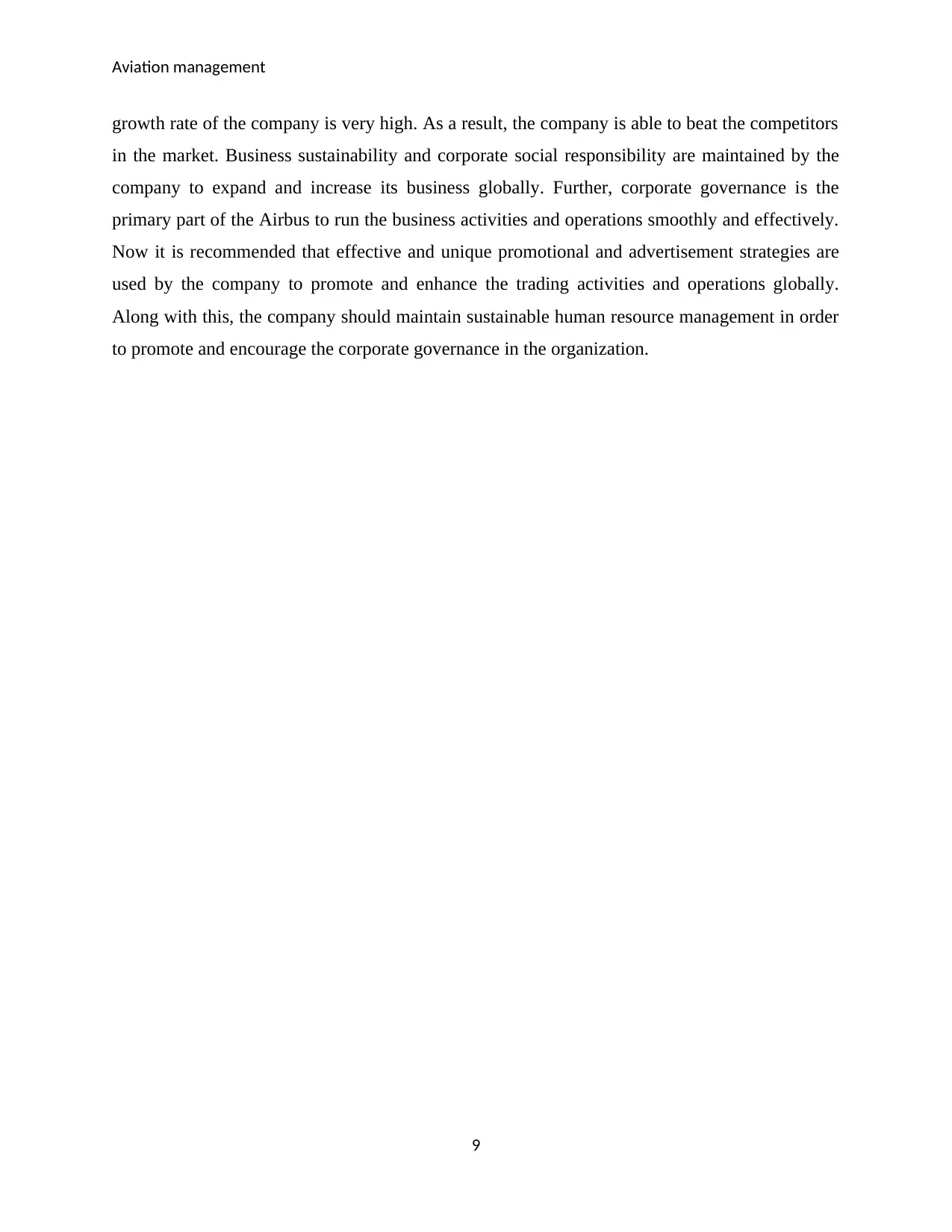
Aviation management
growth rate of the company is very high. As a result, the company is able to beat the competitors
in the market. Business sustainability and corporate social responsibility are maintained by the
company to expand and increase its business globally. Further, corporate governance is the
primary part of the Airbus to run the business activities and operations smoothly and effectively.
Now it is recommended that effective and unique promotional and advertisement strategies are
used by the company to promote and enhance the trading activities and operations globally.
Along with this, the company should maintain sustainable human resource management in order
to promote and encourage the corporate governance in the organization.
9
growth rate of the company is very high. As a result, the company is able to beat the competitors
in the market. Business sustainability and corporate social responsibility are maintained by the
company to expand and increase its business globally. Further, corporate governance is the
primary part of the Airbus to run the business activities and operations smoothly and effectively.
Now it is recommended that effective and unique promotional and advertisement strategies are
used by the company to promote and enhance the trading activities and operations globally.
Along with this, the company should maintain sustainable human resource management in order
to promote and encourage the corporate governance in the organization.
9
⊘ This is a preview!⊘
Do you want full access?
Subscribe today to unlock all pages.

Trusted by 1+ million students worldwide
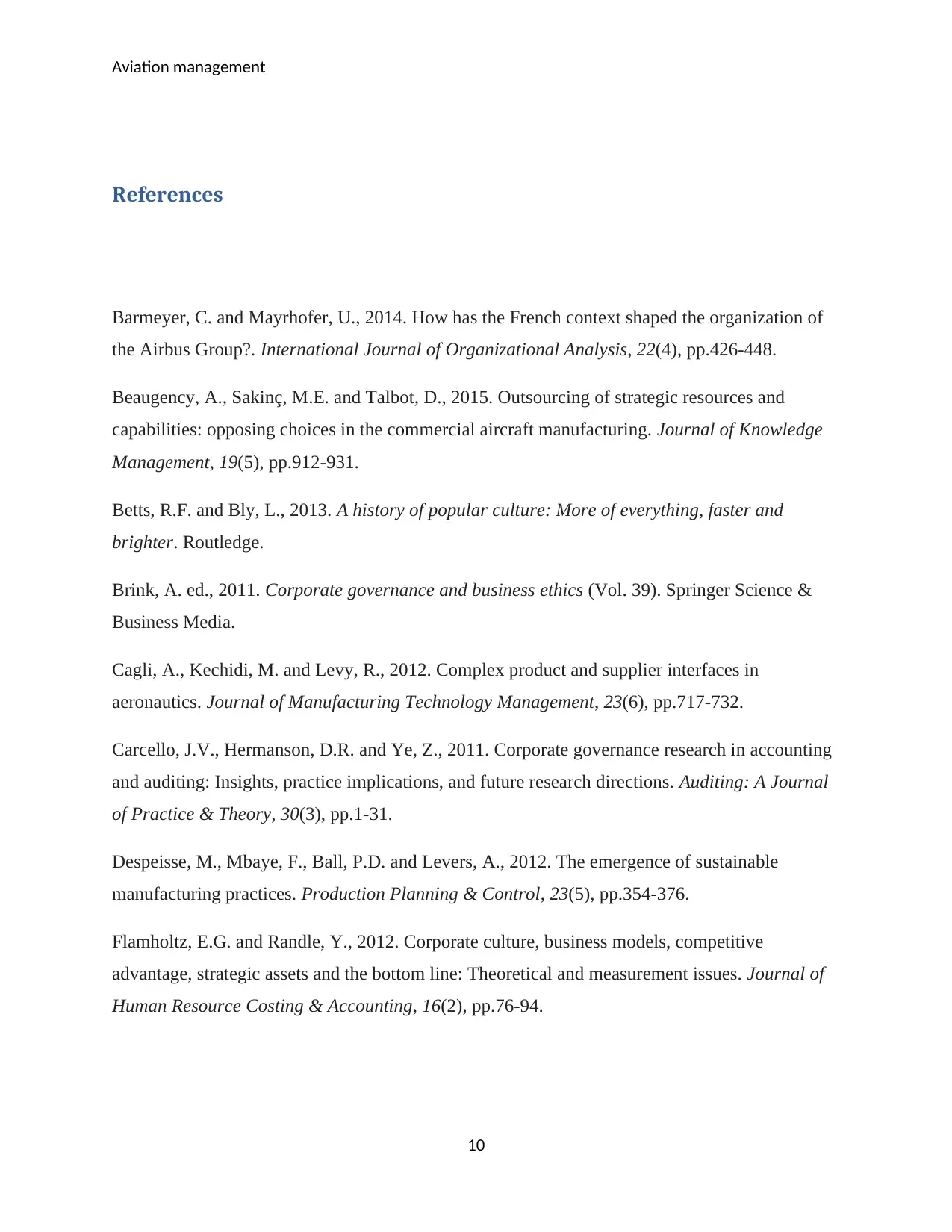
Aviation management
References
Barmeyer, C. and Mayrhofer, U., 2014. How has the French context shaped the organization of
the Airbus Group?. International Journal of Organizational Analysis, 22(4), pp.426-448.
Beaugency, A., Sakinç, M.E. and Talbot, D., 2015. Outsourcing of strategic resources and
capabilities: opposing choices in the commercial aircraft manufacturing. Journal of Knowledge
Management, 19(5), pp.912-931.
Betts, R.F. and Bly, L., 2013. A history of popular culture: More of everything, faster and
brighter. Routledge.
Brink, A. ed., 2011. Corporate governance and business ethics (Vol. 39). Springer Science &
Business Media.
Cagli, A., Kechidi, M. and Levy, R., 2012. Complex product and supplier interfaces in
aeronautics. Journal of Manufacturing Technology Management, 23(6), pp.717-732.
Carcello, J.V., Hermanson, D.R. and Ye, Z., 2011. Corporate governance research in accounting
and auditing: Insights, practice implications, and future research directions. Auditing: A Journal
of Practice & Theory, 30(3), pp.1-31.
Despeisse, M., Mbaye, F., Ball, P.D. and Levers, A., 2012. The emergence of sustainable
manufacturing practices. Production Planning & Control, 23(5), pp.354-376.
Flamholtz, E.G. and Randle, Y., 2012. Corporate culture, business models, competitive
advantage, strategic assets and the bottom line: Theoretical and measurement issues. Journal of
Human Resource Costing & Accounting, 16(2), pp.76-94.
10
References
Barmeyer, C. and Mayrhofer, U., 2014. How has the French context shaped the organization of
the Airbus Group?. International Journal of Organizational Analysis, 22(4), pp.426-448.
Beaugency, A., Sakinç, M.E. and Talbot, D., 2015. Outsourcing of strategic resources and
capabilities: opposing choices in the commercial aircraft manufacturing. Journal of Knowledge
Management, 19(5), pp.912-931.
Betts, R.F. and Bly, L., 2013. A history of popular culture: More of everything, faster and
brighter. Routledge.
Brink, A. ed., 2011. Corporate governance and business ethics (Vol. 39). Springer Science &
Business Media.
Cagli, A., Kechidi, M. and Levy, R., 2012. Complex product and supplier interfaces in
aeronautics. Journal of Manufacturing Technology Management, 23(6), pp.717-732.
Carcello, J.V., Hermanson, D.R. and Ye, Z., 2011. Corporate governance research in accounting
and auditing: Insights, practice implications, and future research directions. Auditing: A Journal
of Practice & Theory, 30(3), pp.1-31.
Despeisse, M., Mbaye, F., Ball, P.D. and Levers, A., 2012. The emergence of sustainable
manufacturing practices. Production Planning & Control, 23(5), pp.354-376.
Flamholtz, E.G. and Randle, Y., 2012. Corporate culture, business models, competitive
advantage, strategic assets and the bottom line: Theoretical and measurement issues. Journal of
Human Resource Costing & Accounting, 16(2), pp.76-94.
10
Paraphrase This Document
Need a fresh take? Get an instant paraphrase of this document with our AI Paraphraser
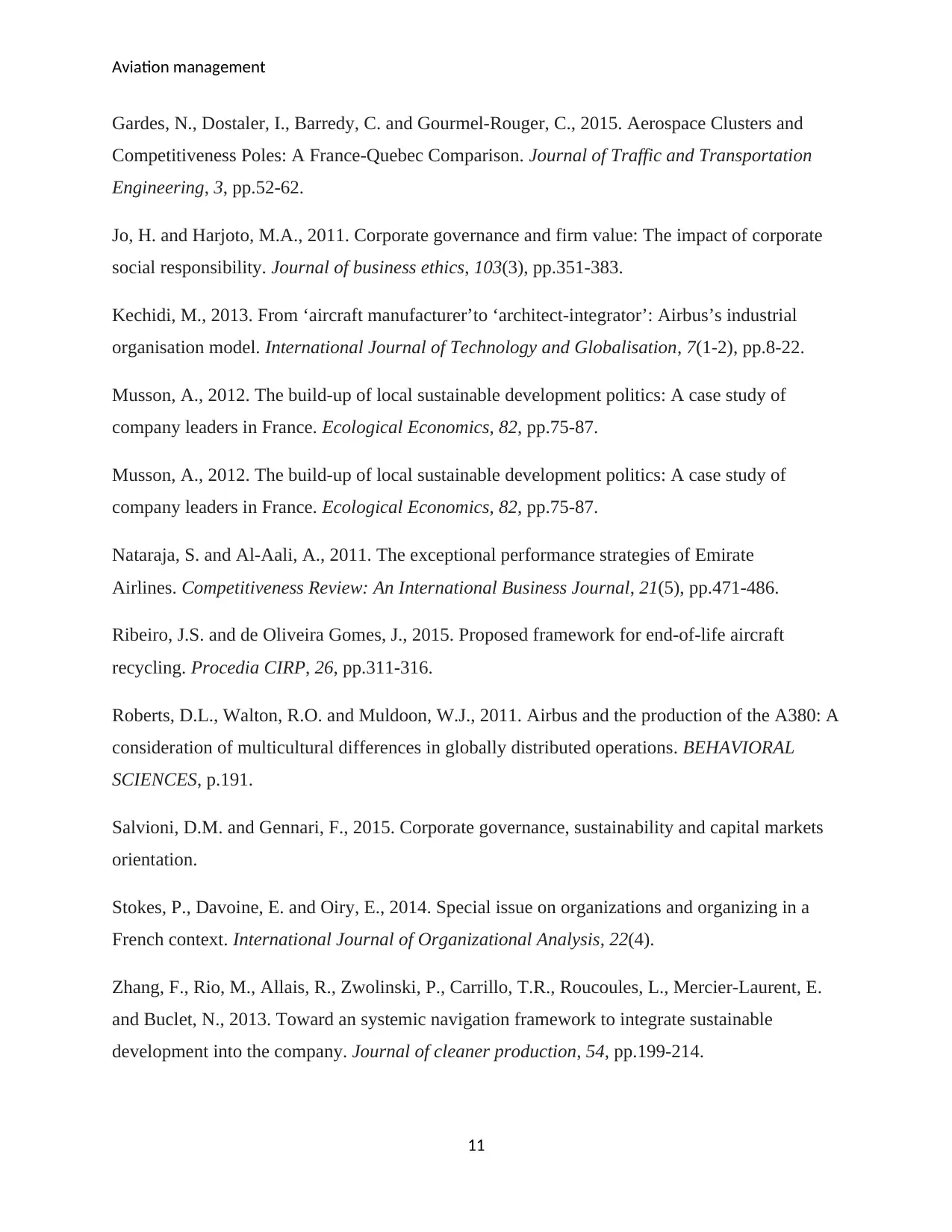
Aviation management
Gardes, N., Dostaler, I., Barredy, C. and Gourmel-Rouger, C., 2015. Aerospace Clusters and
Competitiveness Poles: A France-Quebec Comparison. Journal of Traffic and Transportation
Engineering, 3, pp.52-62.
Jo, H. and Harjoto, M.A., 2011. Corporate governance and firm value: The impact of corporate
social responsibility. Journal of business ethics, 103(3), pp.351-383.
Kechidi, M., 2013. From ‘aircraft manufacturer’to ‘architect-integrator’: Airbus’s industrial
organisation model. International Journal of Technology and Globalisation, 7(1-2), pp.8-22.
Musson, A., 2012. The build-up of local sustainable development politics: A case study of
company leaders in France. Ecological Economics, 82, pp.75-87.
Musson, A., 2012. The build-up of local sustainable development politics: A case study of
company leaders in France. Ecological Economics, 82, pp.75-87.
Nataraja, S. and Al-Aali, A., 2011. The exceptional performance strategies of Emirate
Airlines. Competitiveness Review: An International Business Journal, 21(5), pp.471-486.
Ribeiro, J.S. and de Oliveira Gomes, J., 2015. Proposed framework for end-of-life aircraft
recycling. Procedia CIRP, 26, pp.311-316.
Roberts, D.L., Walton, R.O. and Muldoon, W.J., 2011. Airbus and the production of the A380: A
consideration of multicultural differences in globally distributed operations. BEHAVIORAL
SCIENCES, p.191.
Salvioni, D.M. and Gennari, F., 2015. Corporate governance, sustainability and capital markets
orientation.
Stokes, P., Davoine, E. and Oiry, E., 2014. Special issue on organizations and organizing in a
French context. International Journal of Organizational Analysis, 22(4).
Zhang, F., Rio, M., Allais, R., Zwolinski, P., Carrillo, T.R., Roucoules, L., Mercier-Laurent, E.
and Buclet, N., 2013. Toward an systemic navigation framework to integrate sustainable
development into the company. Journal of cleaner production, 54, pp.199-214.
11
Gardes, N., Dostaler, I., Barredy, C. and Gourmel-Rouger, C., 2015. Aerospace Clusters and
Competitiveness Poles: A France-Quebec Comparison. Journal of Traffic and Transportation
Engineering, 3, pp.52-62.
Jo, H. and Harjoto, M.A., 2011. Corporate governance and firm value: The impact of corporate
social responsibility. Journal of business ethics, 103(3), pp.351-383.
Kechidi, M., 2013. From ‘aircraft manufacturer’to ‘architect-integrator’: Airbus’s industrial
organisation model. International Journal of Technology and Globalisation, 7(1-2), pp.8-22.
Musson, A., 2012. The build-up of local sustainable development politics: A case study of
company leaders in France. Ecological Economics, 82, pp.75-87.
Musson, A., 2012. The build-up of local sustainable development politics: A case study of
company leaders in France. Ecological Economics, 82, pp.75-87.
Nataraja, S. and Al-Aali, A., 2011. The exceptional performance strategies of Emirate
Airlines. Competitiveness Review: An International Business Journal, 21(5), pp.471-486.
Ribeiro, J.S. and de Oliveira Gomes, J., 2015. Proposed framework for end-of-life aircraft
recycling. Procedia CIRP, 26, pp.311-316.
Roberts, D.L., Walton, R.O. and Muldoon, W.J., 2011. Airbus and the production of the A380: A
consideration of multicultural differences in globally distributed operations. BEHAVIORAL
SCIENCES, p.191.
Salvioni, D.M. and Gennari, F., 2015. Corporate governance, sustainability and capital markets
orientation.
Stokes, P., Davoine, E. and Oiry, E., 2014. Special issue on organizations and organizing in a
French context. International Journal of Organizational Analysis, 22(4).
Zhang, F., Rio, M., Allais, R., Zwolinski, P., Carrillo, T.R., Roucoules, L., Mercier-Laurent, E.
and Buclet, N., 2013. Toward an systemic navigation framework to integrate sustainable
development into the company. Journal of cleaner production, 54, pp.199-214.
11
1 out of 11
Related Documents
Your All-in-One AI-Powered Toolkit for Academic Success.
+13062052269
info@desklib.com
Available 24*7 on WhatsApp / Email
![[object Object]](/_next/static/media/star-bottom.7253800d.svg)
Unlock your academic potential
Copyright © 2020–2025 A2Z Services. All Rights Reserved. Developed and managed by ZUCOL.




